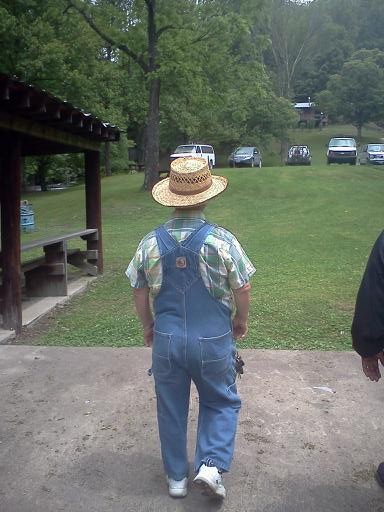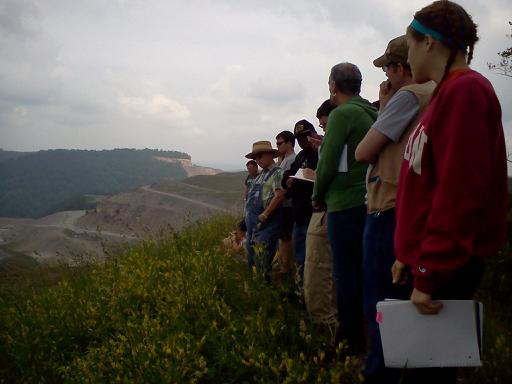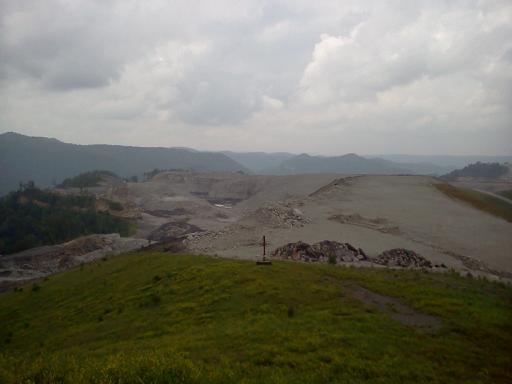Shanay Johnson, OFSC Seminary Student Chair

Midway through Trinity Lutheran Seminary’s one week immersion course, Ministry and Mining in Appalachia, our professor Dr. Mary Hughes took me and my colleagues to the home of dedicated farmer and earth care activist Larry Gibson to learn about the effects of strip-mining—better known as mountaintop removal. The trek up Kayford Mountain was no easy feat (although I might add it paled in comparison to journey down) as we drove our twelve person van at top speeds of 35mph up a steep and winding path. After twenty or so minutes of driving on a paved road, we completed the last 20 minute leg of the journey on a dirt road at a steady 15mph, all the while decorating the van with the dust kicked up on us by the two vehicles in front of us.
Despite these diversions, it was hard to ignore the immense beauty of the surrounding landscape; the richly green forest, the twisting rivers, and the towering hills. Breathtaking as it was, it was no wonder Mr. Gibson called this mountain his beloved home.
Once we reached the top, stretched our legs, and dusted off the van, we joined another group of visitors (the dirt sprayers in front of us) and waited for Larry to arrive. Soon enough, a white SUV hauling a lawn mower pulled in. Watching the SUV slowly back into its parking spot I noticed the rear window was almost completely covered in bumper stickers that read, “I Love Mountains,” “Energy Revolution Now,” “Topless Mountains Are Obscene,” and “Save Kayford Mountain.” I think the driver might have been trying to communicate something…
Before we left our housing accommodations at the Blessed John XXIII Pastoral Center, Dr. Hughes had given us a brief yet unmistakable description of the man we were soon to meet. It was therefore immediately evident when he exited his well ornamented protest vehicle that this was person we had been waiting for.
No more than 5ft tall, Larry Gibson was clothed in a straw hat, jean overalls, plaid shirt, well-worn sneakers, and small black sunglasses. Speaking with a dialect true to his region he was quite possibly the quintessential Appalachian Mountain Man.
While his stature was less than intimidating, his passion for Kayford Mountain shone brightly as he told us the ongoing “David and Goliath” battle that has made him famous in West Virginia and throughout the world.
Kayford Mountain has been in Mr. Gibson’s family since the late 1700s and holds nearly 300 of his deceased relatives in its cemetery. A born and bred farmer, Gibson’s connection to the land is more profound than a suburbanite like me could begin to understand. Gibson’s life is totally dependent on what the land can provide him; produce to sell and make money, food to eat, water to drink, work to keep him busy, trees to give shade, plants to give beauty, air to sustain life, and even animals for company and friendship. As if reading a scene straight from a storybook, Larry spoke with a gentle nostalgia about a curious yet Romantic childhood friendship that blossomed between him, a three-legged fox, and a hawk.
He also described with growing frustration how he must now purchase water and have it delivered to him in 10 gallon jugs because his own well water has been poisoned by the Coal Industry. Because of Coal, his soil is polluted, making the consumption of his produce a potential hazard to himself and his customers.

It is no surprise then that his farming business has suffered a tremendous blow from Coal. Coal is also responsible for making his air quality one of the poorest in the nation. Unfortunately, Larry’s story is not unique. Strip-mining has a widespread negative impact on the surrounding population and has cost families their very livelihood. For this reason, it is not hard to see why the controversy of mountaintop removal incites families to vie for its extinction. And as far as the battle is concerned, Larry Gibson is on the front lines.
At this point, Larry led us across a trail that opened to a clearing overlooking the strip-mining site that is the source of Kayford Mountain’s destruction. As we walked, it was clear that the ground beneath us was extremely rich in coal deposits for it was impossible to take more than five steps without tripping on little black diamonds. The tip of a very expensive iceberg, it is these “diamonds” the coal companies are after.
Mr. Gibson explained that with the coal so close to the surface, it is easier and less costly for industry to get at the coal from the top down. But in order to do this, the workers must first clear the mountain of trees, plants, topsoil, and any animals inhabiting the environment by way of explosives. Next, trucks use enormous shovels to dig into the soil and haul it away or push it into a nearby valley. Finally, draglines dig into the rock to expose the coal so that it can be dug out and transported to a processing plant. This entire process is accomplished with no more than nine workers, boosting corporate profits tremendously.

As we looked out at what was left of Kayford Mountain, we saw nothing more than a vast expanse of rocky, dusty, grey desert. Once the lowest point of the mountain range, Larry showed us how his property now looks down from above onto an empty wasteland. My heart broke to see the vitality and beauty of the Appalachian Mountains reduced to a dead zone. I could only imagine the sorrow Mr. Gibson felt as he watched the land he grew up knowing, loving, and depending on gradually lose its life to strip-mining.
It is no surprise that Industry has been looking to purchase Larry Gibson’s coal-rich land. However, much to their increasing chagrin, Larry refuses to sell his property and support corporate greed. For this act of courageous and persistent protest, Larry has become famous among activists and infamous to the West Virginia Coal Association. Unfortunately, the price he has paid for his decision has garnered serious consequences.
Faced with death threats, gun shots, vandalism, and hate crimes, Mr. Gibson and his family must constantly be on guard for acts of violence aimed to pressure him into selling his land. Larry’s act of defiance has managed to gain national media attention, adding many valuable supporters to his worthy cause. However, while Mr. Gibson has been able to raise awareness and support for Kayford Mountain, there is still more work to be done. Mountaintop removal is not an isolated dilemma and has devastated regions of Virginia, Kentucky, and Tennessee. Not everyone who has been affected by this dangerous practice has amassed the same support as Mr. Gibson and it is up to all of us to continue to work for a healthy earth and a just society.
Shanay Johnson is a graduate student at Trinity Lutheran Seminary in Columbus, Ohio, currently working towards a dual Masters degree in Church Music and Theological Studies. Shanay is the OFSC Board Chair for Seminary Students and will be working with OFSC to further our outreach to seminary students throughout Ohio.

